Amir R, Zeid A (2004) A UML profile for service-oriented architectures. In: Companion to the 19th annual ACM SIGPLAN conference on object-oriented programming systems, languages, and applications, Vancouver. ACM, New York, pp 192–193
Athreya B, Bahmani F, Diede A, Scaffidi C (2012) End-user programmers on the loose: a study of programming on the phone for the phone. In: IEEE symposium on visual languages and human-centric computing, Innsbruck. IEEE, pp 75–82
Atooma (2015) Atooma, a touch of magic. https://www.atooma.com/ . Accessed 1 Oct 2018
[+]
Amir R, Zeid A (2004) A UML profile for service-oriented architectures. In: Companion to the 19th annual ACM SIGPLAN conference on object-oriented programming systems, languages, and applications, Vancouver. ACM, New York, pp 192–193
Athreya B, Bahmani F, Diede A, Scaffidi C (2012) End-user programmers on the loose: a study of programming on the phone for the phone. In: IEEE symposium on visual languages and human-centric computing, Innsbruck. IEEE, pp 75–82
Atooma (2015) Atooma, a touch of magic. https://www.atooma.com/ . Accessed 1 Oct 2018
Ayora C, Torres V, Weber B, Reichert M, Pelechano V (2013) Enhancing modeling and change support for process families through change patterns. In: Nurcan S et al (eds) Enterprise, Business-Process and Information Systems Modeling. BPMDS 2013, EMMSAD 2013, vol 147. Lecture Notes in Business Information Processing. Berlin, Heidelberg, pp 246–260
Benedek J, Miner T (2002) Measuring desirability: new methods for evaluating desirability in a usability lab setting. In: Proceedings from the Usability’s Professionals Association (UPA)
Broke J (1996) SUS. A “quick and dirty” usability scale. In: Jordan P et al (eds) Usability evaluation in industry. Taylor & Francis, London, pp 189–194
Cuccurullo S, Francese R, Risi M, Tortora G (2011) MicroApps development on mobile phones. In: Costabile MF, Dittrich Y, Fischer G, Piccinno A (eds) End-User Development. IS-EUD 2011, vol 6654. Lecture Notes in Computer Science. Berlin, Heidelberg, pp 289–294
Danado J, Paternò F (2014) Puzzle: a mobile application development environment using a jigsaw metaphor. J Vis Lang Comput 25(4):297–315
Danado J, Davies M, Ricca P, Fensel A (2010) An authoring tool for user generated mobile services. In: Berre AJ, Gómez-Pérez A, Tutschku K, Fensel D (eds) Future internet—FIS 2010. FIS 2010, vol 6369. Lecture Notes in Computer Science. Berlin, Heidelberg, pp 118–127
Dey AK, Sohn T, Streng S, Kodama J (2006) iCAP: interactive prototyping of context-aware applications. In: Fishkin KP, Schiele B, Nixon P, Quigley A (eds) Pervasive Computing. Pervasive 2006, vol 3968. Lecture Notes in Computer Science. Berlin, Heidelberg, pp 254–271
Engeström Y, Miettinen R, Punamäki RL (1999) Perspectives on activity theory. Cambridge University Press, Cambridge
Ermagan V, Krüger IH (2007) A UML2 profile for service modeling. In: Engels G, Opdyke B, Schmidt DC, Weil F (eds) Model Driven Engineering Languages and Systems. MODELS 2007, vol 4735. Lecture Notes in Computer Science. Berlin, Heidelberg, pp 360–374
Galitz WO (2002) The essential guide to user interface design: an introduction to GUI. Design principles and techniques. Wiley, New York
Guillen J, Miranda J, Berrocal J, Garcia-Alonso J, Murillo JM, Canal C (2014) People as a service: a mobile-centric model for providing collective sociological profiles. IEEE Softw 31(2):48–53
Häkkilä J, Korpipää P, Ronkainen S, Tuomela U (2005) Interaction and end-user programming with a context-aware mobile application. In: Costabile MF, Paternò F (eds) Human-Computer Interaction—INTERACT 2005, Lecture Notes in Computer Science, vol 3585. Berlin, Heidelberg, pp 927–937
IFTTT (2015) IFTTT, if this then that. https://IFTTT.com/ . Accessed 1 Oct 2018
Klusch M, Sycara K (2001) Brokering and matchmaking for coordination of agent societies: a survey. In: Omicini A, Zambonelli F, Klusch M, Tolksdorf R (eds) Coordination of Internet Agents. Springer, Berlin, Heidelberg, pp 197–224
Locale (2015). http://www.twofortyfouram.com . Accessed 1 Oct 2018
Lucci G, Paternò F (2014) Understanding end-user development of context-dependent applications in smartphones. In: Sauer S, Bogdan C, Forbrig P, Bernhaupt R, Winckler M (eds) Human-Centered Software Engineering. HCSE 2014, Lecture Notes in Computer Science, vol 8742. Berlin, Heidelberg, pp 182–198
Paolucci M, Kawamura T, Payne TR, Sycara K (2002) Semantic matching of web services capabilities. In: Horrocks I, Hendler J (eds) The Semantic Web—ISWC 2002, Lecture Notes in Computer Science, vol 2342. Berlin, Heidelberg, pp 333–347
Renger M, Kolfschoten GL, de Vreede GJ (2008) Challenges in collaborative modeling: a literature review. In: Advances in enterprise engineering I, vol 10, Montpellier, pp 61–77
Repenning A, Ioannidou A (2006) What makes end-user development tick? 13 design guidelines. In: End user development. Human-computer interaction series, vol 9. Springer, Berlin, pp 51–85
Rumbaugh J, Jacobson I, Booch G (2004) The unified modeling language reference manual. Pearson, London
Segal J (2005) Two principles of end-user software engineering research. ACM SIGSOFT Softw Eng Notes 30(4):1–5
Serral E, Valderas P, Pelechano V (2013) Context-adaptive coordination of pervasive services by interpreting models during runtime. Comput J 56(1):87–114
Tasker (2015) Tasker, total automation for Android. http://tasker.dinglisch.net/ . Accessed 1 Oct 2018
Uden L, Valderas P, Pastor O (2008) An activity-theory-based model to analyse web application requirements. Inf Res 13(2):1
Valderas P, Pelechano V, Pastor O (2006) A transformational approach to produce web application prototypes from a web requirements model. Int J Web Eng Technol 3(1):4–42
Valderas P, Torres V, Mansanet I, Pelechano V (2017) A mobile-based solution for supporting end-users in the composition of services. Multimed Tools Appl 76(15):16315–16345
Workflow.is (2018) Workflow. Spend less taps, get more done. https://workflow.is/ . Accessed 1 Oct 2018
Yu J, Sheng QZ, Han J, Wu Y, Liu C (2012) A semantically enhanced service repository for user-centric service discovery and management. Data Knowl Eng 72:202–218
[-]







![[Cerrado]](/themes/UPV/images/candado.png)


